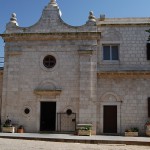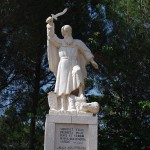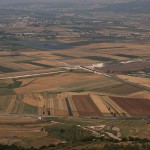Mount Carmel (Israel)
Mount Carmel is a part of the mountain range bearing the same name, which is surrounded by valleys on three sides: the Jezreel Valley, the Valley of Saron, and the Zvulun Valley. The Yokneam River separates Mount Carmel from the Samarian Mountains. Toward the west, in the region of Haifa, Carmel closely approaches the Mediterranean Sea. The waters that stream down its slopes feed two rivers – Kishon and Oren. In winter, it rains heavily here.
The name Carmel is a combination of two Hebrew words: kerem and el (kerem means “grape,” and el means “god”). Indeed, in ancient times, the slopes of Mount Carmel were covered with vineyards and olive tree groves, and it always stood as a symbol of abundance and fertility.
On the mountain, especially in its west part, there are many natural karst caves. Man has long ago favoured these caves and used them for settlements and camps.
All nations at all times believed Mount Carmel to be holy. In a cave, on the slope of the mountain, the Old Testament prophet Elijah lived.
People loved the mountain and the mountain loved them too; that is why there are many legends and traditions that people pass around about the mountain. According to one of them, when Mount Carmel heard that sons of Israel came out of Egypt and headed for the promised land, it moved closer to the Red Sea, and when pharaoh’s soldiers had almost overtaken the Jews, it went down into the sea and allowed the children of Israel to pass over it to the other side. But those, who studied or read the Bible know that in chapter 14 of Exodus it tells how the Lord commanded Moses to stretch his arm over the sea, and Moses stretched his arm over the sea and the Lord caused strong east wind to blow all night long to drive away the sea, and made the sea become dry land, and the waters withdrew. And the sons of Israel walked in the midst of the sea on dry land: and the waters were their walls on their right and on their left.
According to another legend, four mountains: Zion, Sinai, Tabor and Carmel argued among themselves, upon which one of them God would give the Law to His people. God chose Sinai, but promised great glory to the other three. On Zion, He said, Jerusalem would be built, at the foot of Mount Tabor, under the command of prophetess Deborah, Israelites would defeat the Canaanite king, and on Mount Carmel prophet Elijah would live.
Jewish wise men predicted that after the end of days, the Temple would be restored on five mountains, one of which will be Mount Carmel.
The Canaanites, who inhabited this land before the arrival of the Jews, believed that Carmel was the place of habitation of their supreme deity Baal. The Phoenicians worshipped local god Hadad. The Greeks called Carmel the Mount of Zeus and built an altar upon it.
The Romans questioned their oracles here about the destiny that was prepared for them by gods.
History would never “neglect” Mount Carmel. Whatever period of time we take, there definitely would be a place in it for Mount Carmel. Even up to this day, Carmel has not revealed all of its mysteries, and the works there continue. Every year, the mountain unveils its new mysteries.
There is the Maharrakah Monastery on the mountain. The monastery belongs to the Order of Carmelites, who settled down on Mount Carmel back in the days of the crusaders in the XII century, choosing Elijah as their spiritual patron. The word Maharrakah in Arab language means place of burning. The name place of burning is related to prophet Elijah and one story from the Bible.
In the Book of Kings, there is a record of how Jezebel, the wife of the king of north Israel, daughter of the king of Sidon, compelled her husband, Ahab, to build idol worship places and altars for pagan god Baal.
Those, who resisted it, were put to sword by Jezebel. Then prophet Elijah caused a draught to come upon the land, which was so severe that even in the royal palace they came to know what it was like to starve.
Frightened Ahab went to look for Elijah. The latter commanded to summon Baal’s prophets to Carmel and gather all the people there. When the people finally gathered, Elijah proposed to make a burnt offering – each one according to his one way, and whose sacrifice would be accepted – that would be the servant of the true Lord. Baal’s priests prepared a sacrifice and leaped and danced around it from morning until noon, and shouted in a loud voice, and cut themselves with knives and lances so that blood poured from their wounds, but there was no answer for them or even a sign, and their sacrifice was left untouched. When the evening fell, Elijah said, “Hear me, Lord!.. May this people know that You, Lord, are God.” And the fire came down from heaven upon Elijah’s sacrifice and consumed it. “And when all the people saw it, they fell on their faces and they said, “The Lord, He is God!” The people came at the prophets of Baal and slew them. The same night the sky became dark with clouds, and it rained heavily. The draught was over.
At the entrance to the Maharrakah monastery, there is a statue of Elijah the prophet armed with a sword – the same sword, with which he killed the priests who were put to shame. During the Independence War, the statue was damaged. Arab squads, after just another defeat, broke off the punishing hand of the warring prophet, brought it to their camp and smashed it to little pieces. After the war, monks made a new hand for the statue.
On the square before the monastery, there is a door that leads into a church. Basilica of rather small dimensions ends with an altar of twelve stones that symbolize the twelve tribes of Israel: “And Elijah took twelve stones according to the number of the tribes of the sons of Israel.” Ceramic inscription are inlaid in the church altar’s walls, where the scenes of the past events are described.
From the flat roof of the monastery there is a beautiful view of the Mediterranean Sea, Valley of Saron, Samarian Mountains, Mount Gilboa, Jezreel Valley, Nazareth, and – when the weather is fair – of the snow capped Mount of Hermon.



